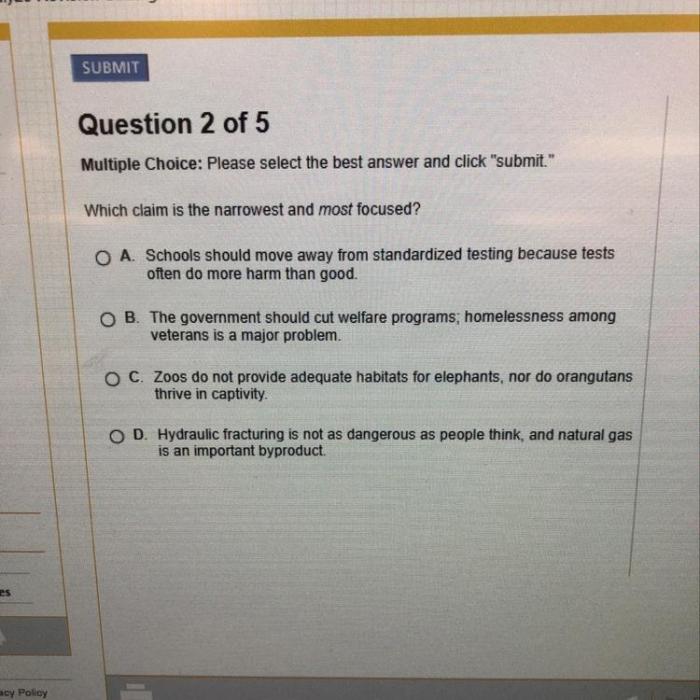Which claim is the narrowest and most focused – In the realm of academic discourse, the ability to craft a narrow and focused claim is paramount. It serves as the foundation for a coherent and compelling argument, guiding readers through a clear and concise exploration of a specific topic.
This guide delves into the intricacies of identifying and developing the narrowest and most focused claim, empowering writers to hone their arguments and achieve maximum impact.
A narrow and focused claim is one that precisely defines the scope and purpose of an argument. It avoids broad generalizations and vague statements, instead zeroing in on a specific aspect of a topic. By doing so, it allows writers to explore their arguments in greater depth and provide a more nuanced understanding of the subject matter.
Narrowest and Most Focused Claim: Which Claim Is The Narrowest And Most Focused

A narrow and focused claim is a statement that is specific, concise, and limited in scope. It is the foundation of any argument or research project, and it is essential for ensuring that the work is clear, well-organized, and persuasive.
Importance of a Narrow and Focused Claim
There are several reasons why it is important to have a narrow and focused claim:
- Clarity:A narrow and focused claim makes it clear what the argument or research project is about. This helps to avoid confusion and ensures that the reader is able to follow the line of reasoning.
- Organization:A narrow and focused claim provides a structure for the argument or research project. It helps to organize the information and make it easier for the reader to understand.
- Persuasiveness:A narrow and focused claim is more persuasive than a broad and unfocused claim. This is because a narrow and focused claim is more specific and therefore more likely to be true. Additionally, a narrow and focused claim is easier to support with evidence.
Characteristics of a Narrow and Focused Claim
There are several key characteristics of a narrow and focused claim:
- Specificity:A narrow and focused claim is specific and does not generalize. It is about a particular topic or issue.
- Conciseness:A narrow and focused claim is concise and to the point. It is not long and rambling.
- Limited in scope:A narrow and focused claim is limited in scope. It does not try to cover too much ground.
The benefits of using a narrow and focused claim include:
- Clarity:A narrow and focused claim makes it clear what the argument or research project is about.
- Organization:A narrow and focused claim provides a structure for the argument or research project.
- Persuasiveness:A narrow and focused claim is more persuasive than a broad and unfocused claim.
Developing a Narrow and Focused Claim
To develop a narrow and focused claim, follow these steps:
- Identify the topic of your argument or research project.
- Brainstorm a list of possible claims.
- Evaluate each claim for specificity, conciseness, and limited scope.
- Select the claim that is most narrow and focused.
Identifying the Narrowest and Most Focused Claim
To identify the narrowest and most focused claim, follow these steps:
- Start with a broad claim.
- Narrow the claim by adding specific details.
- Continue to narrow the claim until it is as specific as possible.
Here are some tips for selecting the narrowest and most focused claim:
- Be specific.Do not generalize.
- Be concise.Keep it short and to the point.
- Be limited in scope.Do not try to cover too much ground.
Examples of Narrow and Focused Claims
| Field | Narrow and Focused Claim |
|---|---|
| History | The American Civil War was fought over the issue of slavery. |
| Science | The theory of evolution is supported by a wealth of evidence. |
| Literature | The Great Gatsby is a novel about the American Dream. |
Avoiding Common Pitfalls
There are several common pitfalls to avoid when developing a narrow and focused claim:
- Making a claim that is too broad.A broad claim is one that covers too much ground. It is difficult to support a broad claim with evidence.
- Making a claim that is too narrow.A narrow claim is one that is too specific. It is difficult to write an interesting or informative argument or research project about a narrow claim.
- Making a claim that is not specific.A non-specific claim is one that does not clearly state what the argument or research project is about.
Applications of Narrow and Focused Claims, Which claim is the narrowest and most focused
Narrow and focused claims can be used in a variety of contexts, including:
- Academic writing:Narrow and focused claims are essential for academic writing. They provide a clear and concise statement of the argument or research project.
- Public speaking:Narrow and focused claims are important for public speaking. They help to keep the speech focused and organized.
- Business writing:Narrow and focused claims are important for business writing. They help to make proposals, reports, and other business documents clear and concise.
Common Queries
What are the key characteristics of a narrow and focused claim?
A narrow and focused claim is specific, clear, concise, and arguable. It identifies a specific aspect of a topic and makes a clear statement about it, providing a roadmap for the argument that follows.
How can I develop a narrow and focused claim?
To develop a narrow and focused claim, start by identifying the main topic of your argument. Then, break it down into smaller s. Choose one that you can explore in depth and craft a statement that makes a specific claim about it.
Why is it important to avoid broad and unfocused claims?
Broad and unfocused claims are difficult to support with evidence and can lead to rambling and unpersuasive arguments. They also make it challenging for readers to follow your train of thought and understand your main point.

